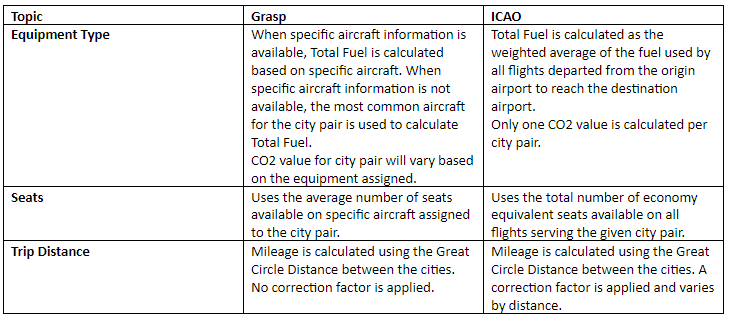The following contains information about the ICAO calculation used in our CO2 reports with ICM in the name.
The following calculation is for our air CO2 reports that include ICM in the report name. Click Here for our page that contains the calculation used for our air CO2 reports that do not have ICM in the report name.
In My Reports, search for keyword ICM to see the reports that use the ICM methodology.
The Grasp CO2 calculation is modeled after the International Civil Aviation Organization (ICAO) methodology and is an estimation of the total CO2 attributed to the leg of a journey.
CO2 Calculation Formula:
- CO2 per pax = 3.16* (total fuel * pax-to-freight factor)/(number of y-seats * pax load factor)
Definitions:
- Total Fuel – the total fuel required to complete the journey for the specific aircraft assigned to the segment.
- Pax-to-freight factor – the ratio of the number of passengers to the mail/freight for a given route. Varies by Region.
- Number of y-seats – average number of seats for the specific aircraft assigned to the segment.
- Pax load factor – the ratio of the number of available seats to the number of passengers. Varies by Region.
- 3.16– a constant that represents the number of tons of CO2 produced by burning a ton of aviation fuel.
Key Differences:

General comments on calculation:
- CO2 is calculated per segment during the importing of the data.
-
All seats are assumed to be economy.
-
Additional Resources:
- ICAO methodology:
- ICAO online calculator:
FAQs:
Why is CO2 0?
- Most likely caused by missing or invalid city codes. When the city code is missing, neither mileage nor region can be determined between the city pair and therefore CO2 cannot be calculated.
Is the Radiative Forcing Index included in the calculation?
- Not at this time.
